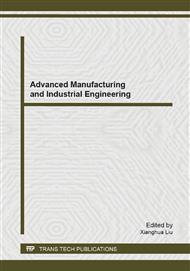p.377
p.381
p.386
p.390
p.394
p.398
p.403
p.407
p.411
Optimizing the Flow Velocity of the Assembly Line: A Cognitive Neuroscience Perspective
Abstract:
Human resource is an indispensible element of industrial engineering. Based on Neuro-Industrial-Engineering, we combine the cognitive neuroscience and information technology with cybernetics, and advance a new intelligent human-machine system. Starting with neurophysiological signal (such as electroencephalogram) collection, the system is capable of real-time monitoring and online assessment of the workers’ physiological states. Based on the physiological information and the production information, the system could detect the bottleneck of the assembly line and realize automatic control of the assembly line’s flow velocity. It largely enhances the response speed of the system, and increase the productivity as well as product quality, which is much more effective than the Toyota system in which the assembly line is only stopped when a specific production accident has been detected during production.
Info:
Periodical:
Pages:
394-397
Citation:
Online since:
August 2014
Authors:
Price:
Сopyright:
© 2014 Trans Tech Publications Ltd. All Rights Reserved
Share:
Citation:


